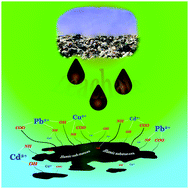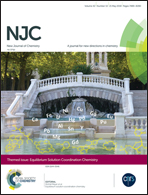A novel thermodynamic approach for the complexation study of toxic metal cations by a landfill leachate†
Abstract
Landfill leachates can contaminate nearby aquifers. The hazards deriving from this contamination also depend on the chemical speciation of various contaminants. A novel approach is proposed here to face this problem from a chemical thermodynamics point of view. The complexing ability of the soluble fraction of a landfill leachate (collected from Bellolampo, Palermo, Italy) towards Pb2+, Cd2+ and Cu2+ has been investigated at T = 298.15 K in NaClaq at I = 0.1 mol dm−3. The soluble fraction of the landfill leachate was first characterized by different analytical techniques. Then, its acid–base properties were studied by ISE-H+ potentiometric titrations and modelled by the so-called diprotic-like model. Differential Pulse Anodic Stripping Voltammetry (DP-ASV) titrations of metal ion aqueous solutions with a diluted landfill leachate were carried out, successively, in order to determine the stability constants of the leachate-metal complexes. The stability of the Pb2+/OH− and Pb2+/Cl− complexes was also studied by the same technique. Finally, the sequestering ability of the leachate towards the investigated metal cations has been quantified by the calculations of various pL0.5 values under different pH conditions. The results proved that the landfill leachate is a good sequestering agent toward those cations, reducing the fraction of the free cations in solution, and that it can be a selective sequestrant at different pH.

- This article is part of the themed collection: Equilibrium Solution Coordination Chemistry


 Please wait while we load your content...
Please wait while we load your content...